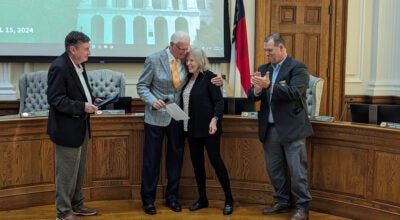Council hears how downtown incentive grants would work
Published 12:00 am Wednesday, September 3, 2014
SALISBURY — Salisbury City Council moved a step closer Tuesday to creating four different downtown grant incentives.
They will aim at spurring growth, especially in downtown residences.
Planning Director Janet Gapen said some benefits from the incentives will include more investment, jobs, housing choices and people in the downtown during nights and weekends.
“People want to be where other people are,” Gapen said.
Council set the establishment of a downtown incentive grant program as one of its goals coming out of a retreat earlier in the year.
After hearing Tuesday how the incentives would work, council set a public hearing on the proposal for its Sept. 16 meeting at City Hall.
Gapen said the city would make some of the incentives retroactive. Projects submitted for development review May 1 and after would be eligible, she said.
Incentive grants would be awarded by council on a case-by-case basis.
The grants could be layered — that is, qualifying downtown projects possibly could receive four different incentive grants.
Three out of the four grants can be used for either new construction or rehabilitation of existing structures.
The fourth grant is for building rehabilitation only.
Interim City Manager John Sofley said a number of developers have inquired about the possible incentives. He added the incentives will represent a cost to the city in the initial years they are introduced, but the city would see a return on its investment later.
Mayor Paul Woodson said Gapen had a “good presentation.”
The four proposed categories of incentive grants would be building rehabilitation, residential production, residential utilities and fire suppression.
For a building rehabilitation grant, a project would be eligible for a grant equal to 25 percent of the total investment, which would have to be at least $100,000.
The maximum building rehabilitation grant would be $50,000.
Eligible improvement costs would include the building shell, exterior facade and systems such as heating and air-conditioning.
With the residential production grant, the project would have to create new residences or make renovations to existing, abandoned units that have not been occupied for at least five years.
The project costs would have to exceed $35 per gross square foot of residential space, and the grant incentive would be calculated at $7 per square foot of the residential space being created or upgraded.
The maximum residential production grant would be $100,000.
A residential utilities grant would only apply to new construction or rehabilitation in which the project creates new residences or renovates existing, abandoned units. The installation or upgrades of water and sewer infrastructure would have to be external to the building.
The maximum residential utilities grant would be $25,000. The eligible costs have to exceed $5,000, and a grant could cover 50 percent of the eligible costs.
Fire suppression grants relate to the installation or expansion of back-alley fire lines capable of serving multiple buildings.
For projects which already have access to a fire line, the grant could be used for installation of a building sprinkler system.
The maximum fire suppression grant would be $25,000. The grant would be calculated at 50 percent of the fire line’s cost, or $2 per square foot for a sprinkler system.
Gapen gave examples of how downtown projects might benefit from the grants.
One example called for a $650,000 building rehabilitation, which would convert an upper floor to residences. The sample project would take in 6,000 square feet, to create six upper floor units.
This project could receive a $50,000 rehabilitation grant, based on 25 percent of the cost, or a maximum grant of $50,000.
It would receive $42,000 in a residential production incentive ($7 time 6,000 square feet); $4,000 for residential utilities (half of the eligible costs of $9,000); and $16,000 for fire suppression (half of the $32,000 cost of a fire line).
The total city incentives for that kind of project would be $112,500.
Gapen also gave an example of how a $5 million project layering all four grants could receive $200,000 in city incentives for a project creating 40 upper floor units out of 40,000 square feet.
In that case, the fire suppression grant was applied to a sprinkler system.
Contact Mark Wineka at 704-797-4263.




